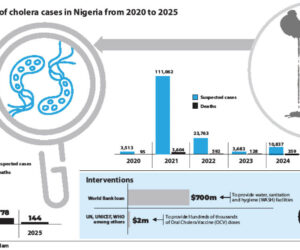The Nigeria Centre for Disease Control and Prevention (NCDC) has reported that at least 176 people have died from Lassa fever across 21 states in 2025.
According to the agency’s Lassa Fever Situation Report for Epidemiological Week 43 (20–26 October 2025), Nigeria has recorded 955 confirmed cases from 8,367 suspected infections across 102 Local Government Areas (LGAs).
Although the total number of infections has slightly decreased compared to the same period in 2024, the latest figures reveal a worsening case fatality rate, which has risen to 18.4 per cent, up from 16.6 per cent recorded during the same period last year.
Ondo state leads
The NCDC report shows that Ondo, Bauchi, Edo and Taraba remain the epicentres of the outbreak, accounting for 88 per cent of all confirmed cases recorded so far this year.
Ondo State alone contributed 37 per cent, followed by Bauchi with 21 per cent, Edo with 17 per cent, and Taraba with 13 per cent.
During the reporting week, the number of new confirmed cases increased slightly from nine in week 42 to 11 in week 43, all reported from Ondo State.
The agency added that the most affected age group remains those between 21 and 30 years, with a median age of 30 and a male-to-female ratio of 1:0.8.
Late presentation and poor health-seeking behaviour
The NCDC noted that the rise in deaths could be linked to late presentation of cases and poor health-seeking behaviour among residents of affected communities.
It also cited the high cost of treatment and poor environmental sanitation as key challenges contributing to the spread and severity of infections in high-burden areas.
Officials said that despite ongoing interventions, these challenges continue to hinder early detection and effective management of the disease, particularly in rural and underserved communities where access to healthcare remains limited.
National response
To strengthen control efforts, the NCDC said its multi-sectoral Technical Working Group (TWG) continues to coordinate response activities at all levels.
The group includes representatives from the Federal Ministry of Health and Social Welfare, World Health Organisation (WHO), Médecins Sans Frontières (MSF), US Centres for Disease Control and Prevention (CDC) and other key partners.
The report highlighted several response measures, including the deployment of National Rapid Response Teams to affected states and the organisation of After-Action Reviews (AARs) in Ondo, Ebonyi and Edo to assess outbreak responses.
Health workers in Bauchi, Benue and Ebonyi states have also been trained on case management, while community sensitisation activities and radio awareness campaigns are ongoing in hotspot areas such as Ondo State.
In addition, the NCDC said it has launched its Infection Prevention and Control (IPC) e-learning platform, powered by DRASA and funded by the Global Fund, to enhance the capacity of frontline health workers.
The agency also distributed ribavirin, personal protective equipment (PPEs), and other essential materials to treatment centres across the country.
It further confirmed that no new healthcare worker infections were recorded in week 43.
Collaborations and research efforts
The agency said it has continued to strengthen partnerships with international bodies to improve surveillance, research and outbreak preparedness.
These include collaborations with Georgetown University, MSF, and the Nigeria Lassa Fever Vaccine Taskforce, co-chaired by NCDC and NAFDAC.
According to the report, the INTEGRATE clinical trial has begun in Ondo State, while Nigeria also participated in the 2nd ECOWAS Lassa Fever International Conference held in Côte d’Ivoire.
These initiatives, the NCDC said, are aimed at promoting regional coordination, vaccine development and access to innovative treatment strategies.
READ ALSO: Lassa Fever: Nigeria records 166 deaths as outbreak spreads across 21 states – NCDC
As the number of deaths continues to rise, the NCDC urged state governments to strengthen year-round community engagement and environmental health campaigns to prevent further spread of the disease.
It also advised healthcare workers to maintain a high index of suspicion for Lassa fever, ensure early diagnosis and initiate timely referral and treatment for suspected cases.
Lassa fever
Lassa fever is an acute viral haemorrhagic illness caused by the Lassa virus, which is transmitted to humans primarily through contact with food or household items contaminated by the urine or faeces of infected rats.
It can also spread from person to person through contact with bodily fluids.
The disease often begins with fever, weakness, and headache, and may progress to more severe symptoms such as bleeding, difficulty breathing, swelling, and organ failure.
Early diagnosis and prompt treatment with Ribavirin are critical for improving survival.










